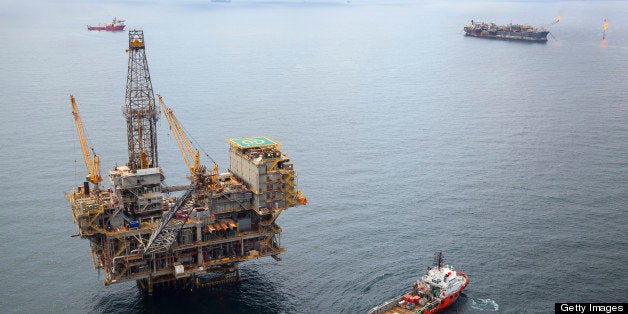
Upon approach, offshore oil and gas platforms appear industrial and lifeless -- devoid of any life, besides the humming of industry. Their potential to function as artificial reef systems seems impossible. Yet, the Rig2Reef Explorers of the Scripps Institution of Oceanography, Amber Jackson, Ashleigh Palinkas and myself, have found that offshore oil and gas platforms provide one of the most unique artificial ecosystems in California.
Artificial reefs are not all created equal. The location, substrate material, structure size and time of year, all effect the variety and density of species found there. So how do oil platforms differ from other types of artificial reefs, such as sunken ships? To explore this question, we set out on an expedition to dive three oil platforms -- Eureka, Elly and Ellen -- in addition to the shipwreck Olympic II, an artificial reef structure very unique from the platforms we have investigated thus far.
Our morning began with us plunging into the surprisingly temperate waters off of San Pedro to dive the Olympic II. The 258-foot Olympic II sank on the morning of September 4, 1940, taking with her the lives of eight men; she was discovered by salvage divers in the 1960s and since then the wreck, sitting in about 100 feet of water has been a popular dive spot for recreational divers to explore and seek out the large sea bass, broom tail grouper and bat stars that hide amongst the wreckage. Although the visibility was lacking on this first dive, with a max of about 10 feet -- it was abundantly clear that the species that called this hulk their home were very different then those found amongst the legs of the platforms. These were more cryptic species -- many of which we had not yet encountered on our platform dives, and schooling fish were entirely absent, as were the colorful waving brittle stars.
Our dives on Eureka, Elly and Ellen, however, were entirely different stories. Eureka, in particular was a spectacular dive. As the largest platform accessible to divers off the coast of California standing in just over 720 feet of water, Eureka boasted an immense and colorful reef. We found ourselves transfixed by the thousands of schooling sardines, tired, but determined Garibaldi defending there newly laid clutches of eggs and jacks hustling betwixt the beams. These platforms were not only rich with life, but diver friendly, allowing relatively unrestrained access to their reefs below -- some divers even proceeded to harvest enormous scallops the size of tennis balls from her legs.
Despite California's law requiring that artificial reefs be placed in areas where they are needed, we found it difficult to deem these artificial structures teeming with life, as not needed. Life thrived amongst the beams of every platform, just as the larger deeper species claimed the ghostly wreckage of the Olympic II to be home. Not only were we able to take away the recreational value of the vibrant beauty generated by the species decorating these platforms -- but we also glimpsed the sustainable harvesting potential of these platforms. A harvest that we not only witnessed, but enjoyed whilst snacking away between dives on raw scallops scraped from Elly, Ellen and Eureka's legs. In this way, we participated in the small circle of life that thrived quietly beneath the industry of oil above.